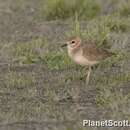Biology
provided by Arkive
A gregarious species, the mountain plover can often be found in loose flocks of up to several hundred birds, especially in winter (2). It forages in grassland habitat or recently cultivated fields for insects. Grasshoppers are one of the primary prey items, but their diet also includes crickets, beetles and flies (2). Like other plovers, this species searches for food in a typically jerky stop-start fashion, running a few steps, stopping abruptly, and them probing the mud with its bill (4). From early November, the mountain plover is found on its warmer wintering grounds, then in mid-March, the plover migrates north-east, probably on a non-stop flight, to its breeding grounds (2).
The mountain plover has a variable breeding system and may be monogamous (one male and one female pair during a breeding season), polyandrous (one female and several males) or polygynous (one male and a number of females). The breeding season extends from late April until July (2), beginning with the females excavating small depressions between clumps of grass where they lay three well camouflaged eggs (7). The male will then start incubating this nest, while the female goes to lay another clutch of three eggs in a second nest. The female may then incubate this clutch herself or, if polyandrous, a second male will carry out incubation leaving the female to lay a third clutch (2). Incubation is carried out for 28 to 31 days and the chicks fledge in 33 to 36 days. Laying a number of clutches in different nests is a clever behavioural adaptation, to compensate for the fact that only 20 to 65 percent of nests are successful due to predation, storms and trampling by cattle (2). This is despite attempts by the small mountain plover to protect its nest from trampling by flying up in the face of approaching cattle (7).
Conservation
provided by Arkive
The conservation of the mountain plover depends on the protection of suitable nesting habitat, the conservation of prairie dogs, and the protection of known nesting sites (8). Efforts to carry out these conservation measures are underway in a number of areas (8) (9), such as the Pawnee National Grassland in Colorado, an important nesting site for the mountain plover and where a mountain plover management strategy has been implemented (2) (8). In addition, the mountain plover and the black-tailed prairie dog Cynomys ludovicianus have been proposed for listing under the Federal Endangered Species Act (5), which would offer more protection to these declining species.
Description
provided by Arkive
This poorly named species is not actually a mountain-dwelling bird, but is endemic to the Great Plains of North America (2). Similarly confusing is that the family to which it belongs, the Charadriidae, is one of the groups known as shorebirds, and this plover occurs nowhere near the shore (4). The plumage of the mountain plover is brownish-grey on the upperparts and whitish on the underparts with a buff wash on the sides. The bright white of the forehead extends back above the eye like an eyebrow and contrasts with the black crown and the black patch that joins the eye to the black, short, straight bill. The pale, yellowish-brown legs are relatively long. Non-breeding adults have a pale brown crown and rufous fringes to the new wing feathers, while juveniles can be identified by the buff-coloured 'eyebrow' (2) (5). The mountain plover calls with drawn-out whistles and a sharp kip note (5).
Habitat
provided by Arkive
Despites its common and scientific names, the mountain plover is not actually a mountain species (2). It nests in upland short-grass prairie disturbed by fire or grazing. During the winter, it is found in heavily-grazed short-grass plains and fields, sandy deserts and on agricultural land (2) (6). They are often found in association with burrowing mammals such as kangaroo rats (Dipodomys species) and prairie dogs (Cynomys species) (2).
Range
provided by Arkive
The mountain plover breeds in central North America, from Montana, south to New Mexico. It winters from central California to Baja California, and east to southern Texas and north-east Mexico (2) (6).
Status
provided by Arkive
Classified as Vulnerable (VU) on the IUCN Red List 2007 (1) and listed on Appendix II of the Convention on the Conservation of Migratory Species (CMS) (3).
Threats
provided by Arkive
Before 1900 the mountain plover was an abundant and important gamebird (2), but during the last century, the number of mountain plovers has decreased (8). Between 1960 and 1991 there was a particularly dramatic decline, with populations decreasing by 63 percent (2). The long-term decline is likely due to hunting (5), but more recently, declines have been primarily the result of threats occurring on the mountain plover's breeding grounds. The prairie habitat occupied by mountain plovers may be the most endangered ecosystem in North America, where native habitat is being lost to agriculture (8). Suitable breeding habitat is also declining due to declines in populations of grazers, which maintain the short grass favoured by the mountain plover. The bison, a former grazer of the Great Plains, is now functionally extinct and the only primary grazer that remains is the prairie dog, although prairie dogs may have declined by as much as 99 percent to their present day numbers through disease, poisoning and recreational shooting (8).

